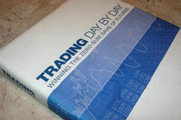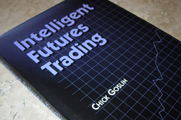Intelligent Futures Trading
A Review by Ed Dobson, President, Traders Press
 Following is a verbatim copy of a review of "Intelligent Futures Trading" (Windsor Books, 1996). This review originally ran in the Investor's Library section of Data Broadcasting Service's monthly newsletter.
Following is a verbatim copy of a review of "Intelligent Futures Trading" (Windsor Books, 1996). This review originally ran in the Investor's Library section of Data Broadcasting Service's monthly newsletter.
In Intelligent Futures Trading Chick Goslin propounds the cogent idea that, while the past is a fact and the present is observable, it is not possible to predict the future. It follows that a trader must reject any tendency to predict a market's future activity since this would fall in the category of prophecy. The author logically concludes that such predictions are not only of no use, but are actually detrimental to the trading process.
What then should be used? Goslin lays out simple rules that essentially involve the interplay of current market action and historical data in order to make an "intelligent guess" at market activity in the immediate future. It can be argued that Goslin minces words and that, in reality, we are always attempting to predict the future when we enter the market. Otherwise, how would we know when to buy or sell? But it is clear that Goslin differentiates between predictions of relatively distant market positions and those of the next day or the next moment. He contends that a sufficiently intelligent guess can be made in this shorter time frame to indicate when a reliable trade is likely.
It would be difficult to argue this point with the author, who has distinguished himself as an outstanding successful trader. In the present book he purportedly reveals the principle method by which he made more than a million dollars in one year. It is a straightforward, simple approach that employs three indicators and price structure. The author recommends that paper charts be used; particularly those supplied by one company which also sells the recommended indicators, two of which are proprietary. However, he explains that these can be approximated adequately with common graphical tools, for which the indicator values are given.
This book is more than a procedural description of a simple trading method. It is an exposition of a proven way of successfully viewing the trading process. Its critical construct is the differentiation of the mental elements of the procedure from the actualization of it. The idea is not new. Several authors have remarked about "analysis paralysis." But Goslin states the problem succinctly and instructs the reader in the gathering of the information that precedes a trade as well as in the subsequent actions required to establish a viable entry. The experienced trader will find it to be a back-to-the-basics reminder of the elements of short-term trading. The part of the book that does not deal with the mechanics of trading is at least as important as the part that does. The "thinking phase" sets the stage properly so that the entry techniques which follow (the "action phase") have an enhanced chance for profit. The author leans on the critical concept that one must not confuse the two phases. More specifically, analysis is not action and it is only knowledge-based, timely action that breeds successful trading.
As for the entry technique, it would be difficult to contest Goslin's simple approach. If, as alluded to on the dust cover, his considerable success in the markets was accomplished "almost exclusively" by means of the momentum techniques in this book, the author has certainly proven their efficacy, at least in his hands. The intent is to enter a trend at its inception or after a retracement, the entry to be determined essentially by the agreement of momentum indicators in several time frames. And therein lies a slight rub. One must possess the discipline to anticipate the movements of the indicators, a skill that we are assured can be learned and for which some scant instructions are provided. This is not the kind of approach that gives a new trader a warm, comfortable feeling as he enters the foray. But it is well known that some of the best trades feel the worst at entry. The warmth and fuzziness develop as a natural consequence of numerous profitable results.
The book is divided into four main segments: 1) understanding the nature of trading and predictive processes, 2) knowing one's self and where he fits in the various trading time frames, 3) the operational techniques, 4) annotated charts. The charts deserve special mention. They encompass thirteen markets over two weeks and are generously annotated with tips as well as illustrations and expansions of the proceeding content. Without them the explanation would be virtually impossible, with them, easily understandable.
This book is well written by a professional trader. It is suitable for neophytes and offers the seasoned trader a view that he may have forgotten or perhaps never had...that of trading on the basis of observable, current market action, unfettered by biased predilection. Goslin's way is only one of many ways to skin the market cat. But, if is probably a valid way and the author has depicted it in compelling style.
Dobson
Traders Press
PO Box 6206
Greenville, SC 29606
Tradersprs@aol.com
Intelligent Futures Trading can be ordered from:
Windsor Books at http://www.windsorpublishing.com
Amazon at http://www.amazon.com

